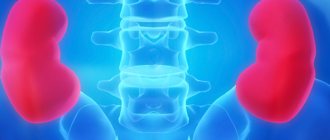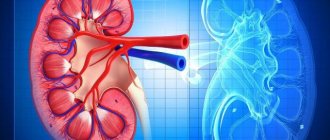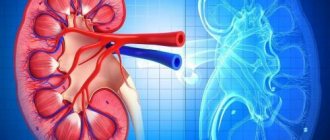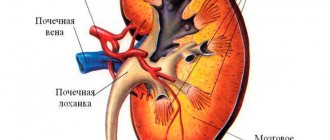- Also, an ultrasound of the kidneys allows you to determine the cause of the disturbance in the outflow of urine from the kidneys (presence of stones, enlargement of the collecting system or obstruction). Under ultrasound guidance, a kidney biopsy is performed, a kidney puncture is performed to extract fluid or pus, and a drainage tube is installed. In the presence of arterial hypertension or varicocele, Doppler ultrasound is performed. After a kidney transplant, the condition of the transplant is assessed using ultrasound. During the ultrasound examination, not only the kidneys are examined, but also the adrenal glands, as well as perinephric tissue.
How to prepare for a kidney ultrasound
In order for the procedure to be successful, the patient needs to fill the bladder. He is recommended to drink about one and a half liters of clean water two hours before the start of the study. You should not drink carbonated water, since the presence of gases in the liquid leads to their accumulation in the intestines, which interferes with the study. You should not drink sweet juices, which lead to intestinal gas pollution.
Immediately before the examination, the patient is asked to remove clothes from the upper half of the body and put on a medical gown. It is better to come to the kidney ultrasound procedure in a tracksuit; a light dress is suitable for a woman. If you plan to visit a functional diagnostics room at a municipal clinic, then bring a towel or disposable napkins with you.
Before the study, the patient must give written consent to the procedure. He needs to explain that during an ultrasound of the kidneys there is no pain, this procedure does not require anesthesia. When applying the gel, you may experience a feeling of slight coolness, which causes discomfort for some particularly sensitive people. It disappears after a few minutes.
How is a kidney ultrasound performed?
The duration of a kidney ultrasound is about thirty minutes. All this time the patient lies on the couch with his back down. The duration of the procedure largely depends on how advanced the device is and how experienced the doctor who conducts the study is. A functional diagnostics doctor applies an indifferent gel to the surface of the body in the lumbar region, and then places a sensor on the skin. An image of the organ appears on the computer monitor. The specialist measures its dimensions and looks at the tissue structure. When performing a kidney ultrasound, this diagnostic method provides a lot of information. It determines the thickness of the renal parenchyma, as well as the volume of their pyelocaliceal system. The doctor can also see stones, enlargement or shrinkage of the kidney, and abnormalities in its structure. If there is an obstacle to good urine flow, ultrasound of the kidneys can show echoscopic signs of hydronephrosis.
It should be remembered that the results of a kidney ultrasound, like studies of other organs, are not a final diagnosis - this is only a medical opinion. To make a diagnosis, the doctor analyzes the data from this study, laboratory tests, fluoroscopy and computed tomography, which he prescribes if indicated.
During a kidney ultrasound, the following diseases and pathological conditions are most often detected:
- congenital anomalies of the kidneys and ureters;
- inflammatory diseases (purulent kidney damage, acute and chronic pyelonephritis);
- urolithiasis;
- kidney cancer;
- hydronephrosis;
- urinary tract obstruction;
- level of stone location.
The procedure for ultrasound examination of the kidneys is usually tolerated without complications and has no contraindications. However, difficulties may arise during the procedure for the following reasons: the presence of gas or barium in the intestines after a recent test procedure, as well as severe obesity.
Treatment options
The compaction of the pyelocaliceal system is caused by various reasons, therefore the treatment methods in each specific case will differ. Depending on the indications, patients are prescribed:
- Pharmacotherapy is drug treatment. To destroy pathogenic flora, antibiotics, antiviral and antifungal agents are used. To make you feel better, symptomatic drugs are prescribed - diuretics, hypotensives, analgesics, anti-inflammatory.
- Hardware therapy is a treatment procedure aimed at improving blood flow, strengthening the immune system, and accelerating tissue regeneration. For kidney pathologies, they resort to magnetic therapy, electrophoresis, and dialysis.
- Surgery is a radical method of treatment, which involves the removal of stones, cysts, neoplasms or a damaged part of an organ. Depending on the indications, pyelolithotomy, percutaneous lithoextraction, nephrectomy, sclerotherapy of the cyst, etc. are performed.
The prognosis of therapy depends on the cause of changes in the pyelocaliceal complex. When treating acute inflammation and renal cysts, recovery occurs in 98% of cases.
Consolidation of the renal joint is a clear sign of kidney disease, which accompanies tumor, congenital and inflammatory diseases. To determine the cause of the pathology, they resort to complex diagnostics - ultrasound, MRI, excretory urography. Timely therapy prevents deterioration of well-being and negative consequences.
Normal echoscopic characteristics on renal ultrasound
On ultrasound, the normal thickness of an adult kidney is in the range from forty to fifty millimeters, its width is from fifty to sixty millimeters, and its length can be from one hundred to one hundred and twenty millimeters. The thickness of the organ parenchyma is about twenty-three millimeters. With age, it decreases and by the age of sixty it can reach twenty-three millimeters.
On ultrasound, the kidneys have a bean-shaped shape, as well as an even, clear outer contour. The left kidney is located slightly higher than the right. The thickness of the kidney capsule is one and a half millimeters, it is hyperechoic. The echoscopic density of the kidney pyramids is slightly lower than that of the parenchyma, and the renal sinus is identical in echoscopic density to the perirenal tissue. The kidneys have the same echogenicity as the liver, or their echogenicity may be slightly lower.
Normally, the pyelocaliceal system is not visualized; it is anechoic when the bladder is full. On ultrasound, the anterior-posterior dimensions of the kidney are no more than fifteen millimeters, and the mobility of the organ during breathing is from two to three millimeters. The sizes of both kidneys can be the same or differ by no more than two centimeters.
At the conclusion of the ultrasound, the doctor indicates whether there is an abnormality in the structure of the kidneys. It emphasizes whether there is aplasia or hypoplasia, a cyst, as well as a spongy kidney. Attention is also drawn to the presence of space-occupying formations, their echogenicity and echostructure. If a kidney ultrasound reveals stones, then you need to indicate how many there are, what their diameter is, and on which side they were found. The location of the stones is also determined and whether there is an acoustic shadow near them or not.
What is dilatation?
Dilatation of the kidneys is an expansion of their pyelocaliceal system, in other words, it is also called pyelectasia. There is both enlargement of one kidney and dilatation of the ventral joints of both kidneys.
Most often, the pathology is detected in early childhood; boys are more susceptible to this problem. Urine accumulates in the renal pelvis, after which it is transported to the calyces, and from there to the ureters. If the outflow of urine is obstructed, dilatation of the renal pelvis occurs.
The dilation may be mild, moderate or severe.
The reason why kidney dilatation occurs is:
- intrauterine pathology of kidney formation in the fetus;
- abnormal location of the kidney;
- excess fluid intake;
- increased pressure in the bladder;
- stone blockage that interferes with the flow of urine;
- inflammatory kidney diseases;
- a neoplasm that interferes with the flow of urine.
In addition, dilatation of the kidney may occur during pregnancy. This is due to physiological changes in the woman’s body. Enlargement of the chest joint occurs in 80-90% of women in the second trimester, and in most cases disappears on its own a couple of weeks after birth.
However, dilatation is a risk factor in the occurrence of cystitis, pyelonephritis and other diseases of the urinary system during pregnancy.
Note! Dilatation of the kidneys is not an independent disease, but only indicates the presence of a problem.
Most often, kidney enlargement is not determined externally and is detected only during the diagnostic process.
However, in some cases, the clinical picture is still present, and then signs of dilatation of the maxillary joint may be as follows:
- pain in the lower back;
- frequent urination;
- feeling of incomplete emptying of bladder;
- the occurrence of edema;
- feeling of weakness;
- increase in body temperature.
In most cases, the symptoms that appear depend on the underlying disease. For example, hematuria with dilatation indicates the presence of a stone blocking the urinary duct. In addition, dilatation of the pelvis of the left kidney or right kidney may be accompanied by a significant increase in the urinary duct, ectopia or vesicoureteral reflux.
We already know what kidney dilatation is, but what is its danger? If the difficulty in the outflow of urine is not eliminated in a timely manner, compression of the kidney tissue and atrophy will occur. This will be followed by a gradual decrease in kidney function, and then its complete death. Impaired outflow of urine can be complicated by pyelonephritis, which in this case can be aggravated by hardening of the kidney tissue.
In 70% of children, dilation of the kidneys occurs in the first year of life. Expansion of the pelvis can occur during intrauterine development. The calyces and pelvis are involved in the accumulation and excretion of urine. Dilation of the kidneys may be accompanied by lower back pain. Other symptoms are associated with the reasons that caused the dilatation. If you contact a urologist in a timely manner, it is possible avoid complications
Methods for dilatation diagnosis
Before proceeding with the treatment of this deviation, the necessary diagnostics should be carried out. First of all, you need to seek medical advice. During the examination, it is impossible to determine that there is dilatation of the pelvis of the right kidney, so they resort to other diagnostic methods, namely, an ultrasound examination of the kidneys. It is noteworthy that laboratory tests also cannot determine whether enlargement of the cerebral palsy is present.
The doctor can refer a patient of any age and gender for an ultrasound scan. This method is absolutely harmless and is highly informative.
The instructions for conducting the study are quite simple:
- The patient is placed on the couch in a supine position (according to the doctor’s instructions, it is sometimes necessary to change the position), freeing the required area of the body from clothing.
- The doctor applies a special gel that prevents the penetration of air between the sensor and the human body, and in general is a kind of conductor that provides acoustic communication. The gels are safe and do not stain clothes.
- During diagnosis, the specialist evaluates the location and size of organs, the condition of the parenchyma; reveals signs of the inflammatory process, stones and neoplasms.
- The procedure takes approximately 10-30 minutes, it is completely safe and painless, and its price starts from 400 rubles.
In some cases, additional urography or cystography may be necessary. During an ultrasound scan during pregnancy, dilatation of the renal joints of both kidneys can be detected in the fetus at 18-22 weeks.
Without treatment, kidney atrophy may occur
From the photos and videos in this article, we learned about what kidney dilatation is, for what reasons it develops, and we also received information on how to detect this disorder.
Ultrasound of the kidneys in children
In childhood, ultrasound of the kidneys is done for the following purposes:
This study is performed if a child has pain or discomfort when urinating, after an injury to the lumbar region or abdomen, or if there is hyperthermia or swelling after a viral disease. Indications for ultrasound of the kidneys and bladder in newborns are as follows:
- pathological changes detected in urine analysis;
- increased bilirubin levels;
- the presence of a tumor-like formation in the abdominal cavity;
- swelling in the morning;
- visible external congenital malformations;
- kidney disease in the child’s parents;
- dysbiosis diagnosed immediately after birth;
- severe pregnancy in the mother or pathological birth;
- finding the child in the intensive care unit after birth;
- resuscitation measures performed after the birth of the baby;
- decrease in daily urine volume;
- arterial hypertension of unknown origin (with systolic blood pressure above eighty millimeters of mercury, and diastolic blood pressure above sixty-five).
Indications for ultrasound of the urinary system
Any examination, even one as safe and non-traumatic as an ultrasound examination, must be carried out according to indications. For ultrasound examination, the reasons for conducting diagnostics are:
- observation for chronic diseases of the urinary system (pyelonephritis, glamerulonephritis, cysts, etc.);
- preventive examination;
- regular headaches of a migraine nature, as well as against the background of hypertension;
- swelling of the lower extremities, face;
- endocrine diseases;
- congenital pathologies of the genital organs;
- injuries and pain in the lumbar region;
- disturbance of urination (frequency, incontinence, pain during the process), suspicion of hydronephrosis;
- renal colic;
- changes in OAM data (protein, blood, mucus in urine).
Variants of the norm on ultrasound of the kidneys in children
Children's normal kidneys have smooth contours and a clearly visible fibrous capsule. The size of a child’s kidneys depends not only on his age, but also on his height. If the baby’s height is between fifty and eighty centimeters, then ultrasound measures only two indicators of the kidney - its length and width.
The parameters of the left and right kidneys are recorded separately. The length of the left kidney can vary from forty-eight to sixty-two millimeters, and the length - from forty-five to fifty-nine millimeters. The left kidney should be from forty-eight to sixty-two millimeters wide, and the length should be from forty-five to fifty-nine millimeters. The width of the left kidney can be from twenty-two to twenty-five millimeters, and the right one - from twenty-two to twenty-four millimeters. At the same time, in children from one to two meters tall, the thickness of the kidney parenchyma is measured. Its dimensions range from nine to eighteen millimeters for the left kidney, and in the right kidney it can reach from ten to seventeen millimeters.
If you need to perform an ultrasound of the kidneys, contact the IVF Center clinic in Smolensk. We conduct research using modern equipment, which allows us to see minimal changes in the structure of the organ. Our specialists are always happy to help you.









